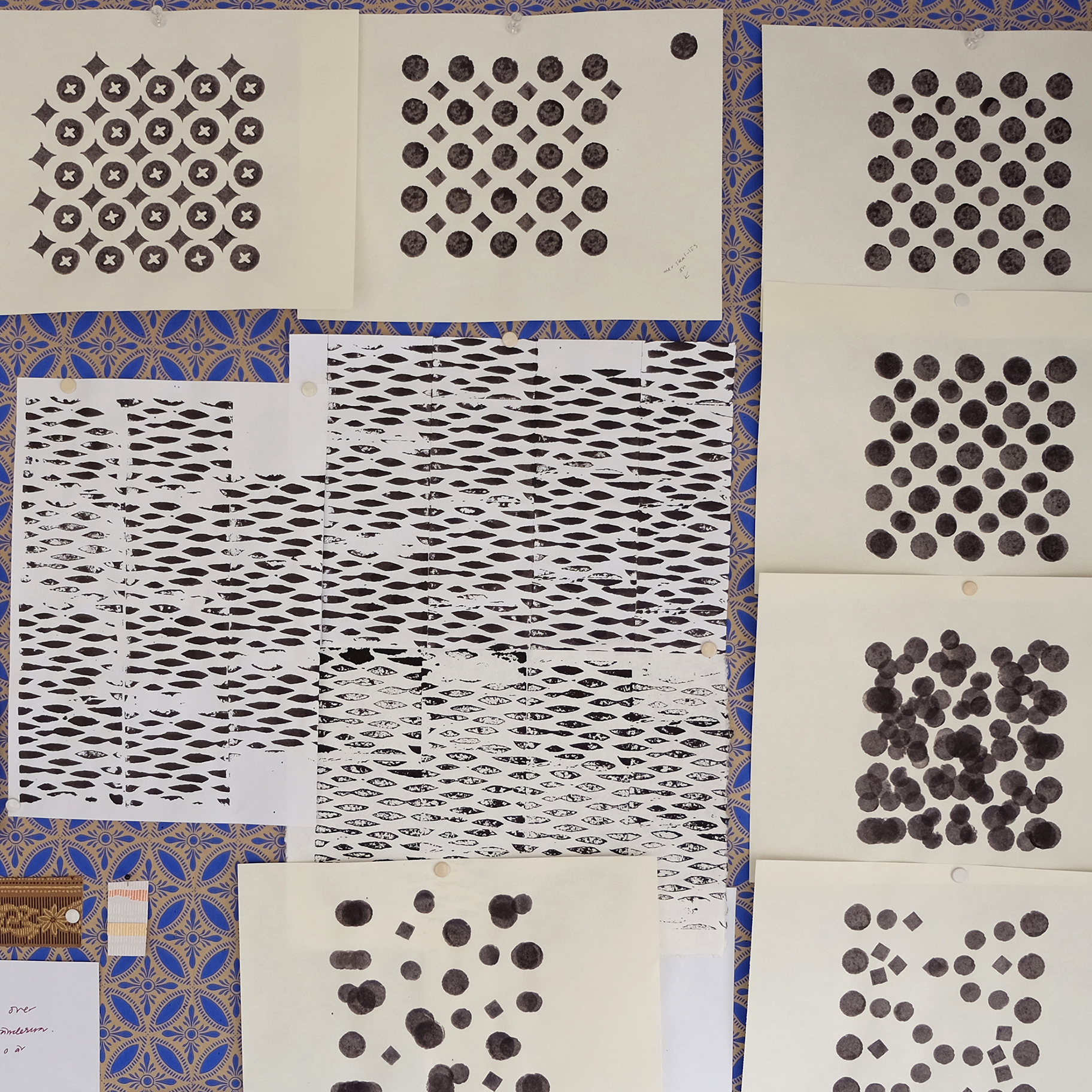To slip out of the geometric straitjacket
Using the tunnel method to promote irregularity in wallpaper patterns
DOI:
https://doi.org/10.7577/formakademisk.5435Emneord (Nøkkelord):
irregularity, sustainability, craft research, wallpaper patterns, artistic researchSammendrag
The tunnel method is a technique employed in the design of wallpaper patterns to facilitate the hanging process while maintaining the integrity of the pattern. It can be utilised in both the reconstruction of historical patterns and the creation of new ones. I have explored the potential of this method since 2006, and in my latest project, I had the opportunity to document its application in Swedish wallpaper studios and endeavour to understand its historical background regarding cultural and printing conditions. By testing the effect of applying the method to wallpaper patterns, I explored its possibility of generating distinctive effects within the pattern when the wallpaper is installed. In this way, the user can actively participate in determining the degree of variation in the pattern during the installation process, either by embracing serendipity or by making deliberate choices. The purpose is to promote wallpaper patterns with greater variation and wallpapers made from sustainable materials. Although this investigation led to several different ways of utilising the tunnel method, there is still much to be explored in this field. By sharing my work, I aim to motivate more people to explore the potential of the tunnel method. Notably, the communication of its functionality to customers and its integration within the cultural context remain limited.
Referanser
Andersson Møller, V., (2013). Danske Kunstnertapeter 1930–1965 [Danish Artist Wallpaper 1930–1965]. Rhodos forlag.
Broström, I., & Stavenow-Hidemark, E. (2004). Tapetboken, papperstapeten i Sverige [The wallpaper book, the paper wallpaper in Sweden.]. Byggförlaget.
Cooper Hewitt, Smithsonian Design Museum. (2020). Online Collection. Retrieved August 8, 2023, from https://collection.cooperhewitt.org/
Deutsches Tapetenmuseum. Online Collection. Retrieved August 11, 2023, from https://www.tapeten.museum-kassel.de
Hanaor, C. (Ed.). (2006). The Cutting Edge of Wallpaper. Black Dog Publishing.
Hoskins, L. (2005). The papered wall, The history, Patterns and Techniques of Wallpaper. Thames & Hudson.
Jaime Hayón. Collection for eco wallpaper. Retrieved May 13, 2023, from https://www.hayonstudio.com/design/jaime-hayon-collection-for-eco-wallpaper/
Korn, M. (2022). Oregelbundna tapetmönster, alternativa metoder för mönsterpassning [Irregular wallpaper patterns, alternative methods of pattern matching]. Hantverkslaboratoriet. https://gupea.ub.gu.se/handle/2077/73376
Kulling, O., Larsson, E., & Svensson, L. (1971). Tapetboken, en orientering om papperstapeter, tapetval och ta-petsering [The wallpaper book, an orientation on paper wallpaper, wallpaper selection and wallpapering]. Tapetrådet.
Korn, M. (2023). Tapeter [Wallpapers].Retrieved August 11, 2023, from https://www.mirjamkorn.se/tapeter/
Musée du Papier Peint. Online Collection. Retrieved from https://www.museepapierpeint.org/en/wallpaper/online-resources/
Studio Lisa Bengtsson. (2021.). Category: Tapeter [Wallpapers]. Retrieved August 11, 2023, from https://www.studiolisabengtsson.se/category/tapeter
Tapetorama. Vintagetapeter [Vintage wallpaper]. Retrieved May 14, 2023, from https://www.tapetorama.se/vintagetapeter/
Victoria and Albert Museum. Collections/wallpaper. Retrieved April 9, 2023, from https://www.vam.ac.uk/collections/wallpaper/
Wängberg-Eriksson, K. (1998). Pepis flora: Josef Frank som mönsterkonstnär [Pepi's flora: Josef Frank as pattern artist]. Signum.

Nedlastinger
Publisert
Hvordan referere
Utgave
Seksjon
Lisens
Opphavsrett 2023 Mirjam Korn

Dette verket er lisensiert under Creative Commons Attribution-NoDerivatives 4.0 International License.
- Forfatteren(e) beholder sin opphavs- og kopieringsrett til eget manuskript, men gir tidsskriftet varig rett til 1) å fremføre manuskriptet for offentligheten i den opprinnelig publiserte digitale form, og 2) å registreres og siteres som første publisering av manuskriptet.
- Forfatteren må selv forvalte sine økonomiske kopieringsrettigheter overfor eventuell tredjepart.
- Tidsskriftet gir ingen økonomisk eller annen kompensasjon for innsendte bidrag, medmindre det er gjort særskilt avtale om dette med forfatteren(e).
- Tidsskriftet plikter å arkivere manuskriptet (inklusive metadata) i den opprinnelig publiserte digitale form, i minst ett dertil egnet åpent tilgjengelig langtidsarkiv for digitalt materiell, som for eksempel i de norske universitetenes institusjonsarkiv innen rammen av NORA-samarbeidet.
Verket vil bli publisert OpenAccess med en Creative Commons 4.0-lisens som tillater alle å lese, dele og tilpasse innholdet, også kommersielt, under lisensvilkårene:
Dette verket må tilskrives/ krediteres på riktig måte, en lenke må gis til CC-BY 4.0-lisensen, og endringer som er gjort må angis på en rimelig måte, men ikke på noen måte som antyder at lisensgiveren støtter deg eller din bruk.



